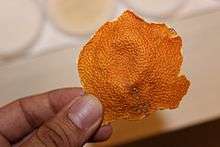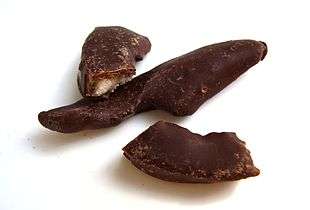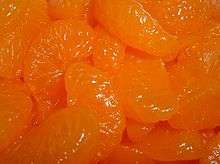Mandarin orange
| Mandarin orange | |
|---|---|
| Scientific classification | |
| Kingdom: | Plantae |
| Clade: | Angiosperms |
| Clade: | Eudicots |
| Clade: | Rosids |
| Order: | Sapindales |
| Family: | Rutaceae |
| Genus: | Citrus |
| Species: | C. reticulata |
| Binomial name | |
| Citrus reticulata Blanco, 1837 | |
The mandarin orange (Citrus reticulata), also known as the mandarin or mandarine, is a small citrus tree with fruit resembling other oranges, usually eaten plain or in fruit salads. Specifically reddish-orange mandarin cultivars can be marketed as tangerines, but this is not a botanical classification.
Mandarins are smaller and oblate, rather than spherical like the common oranges (which are a mandarin hybrid). The taste is considered less sour, as well as sweeter and stronger.[1] A ripe mandarin is firm to slightly soft, heavy for its size, and pebbly-skinned. The peel is very thin, with very little bitter white mesocarp,[2] so they are usually easier to peel and to split into segments. Hybrids generally have these traits to a lesser degree.
The mandarin orange tree is more drought-tolerant than the fruit. The mandarin is tender and is damaged easily by cold. It can be grown in tropical and subtropical areas.
According to molecular studies,[3] the mandarin, the citron, the pomelo, and to a lesser extent the papedas and kumquat, were the ancestors of most other commercial citrus varieties, through breeding or natural hybridization; mandarins are therefore important as the only sweet fruit among the parental species. Though some mandarin cultivars remain pure, most have some degree of pomelo hybridization, while in some cases the amount of pomelo is substantial.
Biological description
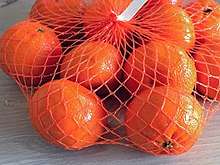
Citrus reticulata is a moderate-sized tree[4] usually not exceeding 4 m (13 ft) in height; however, a 30-year-old tree can reach 5 metres (16 ft) (such a tree can yield some 5–7 thousand fruits).[5] The tree generally has thorns.[6]
The leaves are shiny and green,[6] rather small.[4] The petioles are short, almost wingless[4] or slightly winged.
The flowers are borne singly or in small groups in the leaf-axils.[6]
Citrus are usually self-fertile (needing only a bee to move pollen within the same flower) or parthenocarpic (not needing pollination and therefore seedless, such as the satsuma).
Fruit
Mandarin orange fruits are small (4 to 8 cm). Their color is orange,[7] orange-yellow,[8] or orange-red.[9] Their shape is spherical or oblate (flattened at the poles).[7][8][10]
The skin is thin and peels off easily.[10][11] Their easiness to peel is an important advantage of mandarin oranges over other citrus fruits that all are more difficult to peel.[11][12][13]
Just like with other citrus fruits, the endocarp (inner flesh) is separated into segments, which in their turn consist of a large number of elongated cells.[14]
The fruits may be seedless or contain a small number of seeds.[7]
Mandarin orange fruits are sweet to taste. They can be eaten as whole or squeezed to make juice.[15] They can also be dried.[12]
The fruits contain a large amount of sugar (up to 10.5%), vitamins C, B1, B2, provitamin A, free organic acids, phytoncides, lectins, and mineral salts.[15]
The vitamin C in mandarin oranges is perfectly preserved in long-term storage. Since mandarin oranges ripen in November–December, they can be a source of vitamins during the winter for people living in the Northern Hemisphere.[15]
Etymology
The name "mandarin orange" is a calque of Swedish mandarin apelsin (apelsin from German Apfelsine=Apfel+Sino means chinese apple), first attested in the 18th century. The form "mandarine" derives from the French name for this fruit. The reason for the epithet "mandarin" is not clear; it may relate to the yellow colour of some robes worn by mandarin dignitaries.[16][17]
Uses
Fresh mandarins
Mandarins are generally peeled and eaten fresh. The fresh fruit is also used in salads, desserts and main dishes. Fresh mandarin juice and frozen juice concentrate are commonly available in the United States. The number of seeds in each segment (carpel) varies greatly.
Peel
The peel is used fresh, whole or zested, or dried as chenpi. It can be used as a spice for cooking, baking, drinks, or candy.
Canning
Canned mandarin segments are peeled to remove the white pith prior to canning; otherwise, they turn bitter. Segments are peeled using a chemical process. First, the segments are scalded in hot water to loosen the skin; then they are bathed in a lye solution, which digests the albedo and membranes. Finally, the segments are rinsed several times in plain water. Once orange segments are properly prepared, mandarin oranges undergo heat processing to remove bacteria that can cause spoilage. The oranges are then packed in airtight sealed containers. Ascorbic acid may also be added.[18] They are often used in salads, desserts, and baking.
Traditional medicine
In traditional Chinese medicine, the dried peel of the fruit is used in the regulation of ch'i, and also used to treat abdominal distension, to enhance digestion, and to reduce phlegm.[19] Mandarins have also been used in ayurveda (traditional medicine of India).[20]
Cultivation
The fruit yield is high, up to 5-6 thousand fruits per tree in a favorable year.[11]
In 2016, world production of mandarin oranges (combined with tangerines, clementines, and satsumas in reporting to FAOSTAT) was 32.8 million tonnes, led by China with 52% of the global total (table).[21] Producing more than one million tonnes each in 2016 were Spain, Turkey, Morocco, and Egypt.[21]
Mandarin orange is the most cultivated citrus fruit in China, tropical Asia, India, Korea, Japan, the Mediterranean, and in Florida in the United States. A hardy Japanese species of mandarin orange called unshiu is grown in the Caucasian country of Georgia which is a major exporter of mandarins to Ukraine, Russia, Belarus, Kazakhstan, Kyrgyzstan, Armenia and Azerbaijan,[22][23] although there is also some production in Russia on the Black Sea coast of Caucasus and in the Krasnodar Region.[11]
Production volume
| Tangerines, mandarins, clementines, satsumas Top 20 producers in 2011 (1000 tonnes) | |
|---|---|
| 12,482 | |
| 2,117 | |
| 1,005 | |
| 928 | |
| 872 | |
| 853 | |
| 848 | |
| 800 | |
| 753 | |
| 681 | |
| 596 | |
| 515 | |
| 406 | |
| 401 | |
| 360 | |
| 236 | |
| 218 | |
| 197 | |
| 179 | |
| 152 | |
| All other | 1,582 |
| World total | 26,030 |
| Source: UN Food and Agriculture Organisation (FAO),[24] | |
Nutrition
| Nutritional value per 100 g (3.5 oz) | |
|---|---|
| Energy | 223 kJ (53 kcal) |
|
13.34 g | |
| Sugars | 10.58 g |
| Dietary fiber | 1.8 g |
|
0.31 g | |
|
0.81 g | |
| Vitamins | Quantity %DV† |
| Vitamin A equiv. |
4% 34 μg1% 155 μg |
| Thiamine (B1) |
5% 0.058 mg |
| Riboflavin (B2) |
3% 0.036 mg |
| Niacin (B3) |
3% 0.376 mg |
| Pantothenic acid (B5) |
4% 0.216 mg |
| Vitamin B6 |
6% 0.078 mg |
| Folate (B9) |
4% 16 μg |
| Choline |
2% 10.2 mg |
| Vitamin C |
32% 26.7 mg |
| Vitamin E |
1% 0.2 mg |
| Minerals | Quantity %DV† |
| Calcium |
4% 37 mg |
| Iron |
1% 0.15 mg |
| Magnesium |
3% 12 mg |
| Manganese |
2% 0.039 mg |
| Phosphorus |
3% 20 mg |
| Potassium |
4% 166 mg |
| Sodium |
0% 2 mg |
| Zinc |
1% 0.07 mg |
| Other constituents | Quantity |
| Water | 85.2 g |
|
| |
| |
|
†Percentages are roughly approximated using US recommendations for adults. Source: USDA Nutrient Database | |
A mandarin orange contains 85% water, 13% carbohydrates, and negligible amounts of fat and protein (table). Among micronutrients, only vitamin C is in significant content (32% of the Daily Value) in a 100 gram reference serving, with all other nutrients in low amounts.
Cultural significance
During Chinese New Year, mandarin oranges/tangerine/satsumas are considered traditional symbols of abundance and good fortune. During the two-week celebration, they are frequently displayed as decoration and presented as gifts to friends, relatives, and business associates.
Mandarin oranges, particularly from Japan, are a Christmas tradition in Canada, the United States and Russia.
In the United States, they are commonly purchased in 5- or 10-pound boxes, individually wrapped in soft green paper, and given in Christmas stockings. This custom goes back to the 1880s, when Japanese immigrants in the United States began receiving Japanese mandarin oranges from their families back home as gifts for the New Year. The tradition quickly spread among the non-Japanese population, and eastwards across the country: each November harvest, "The oranges were quickly unloaded and then shipped east by rail. 'Orange Trains' – trains with boxcars painted orange – alerted everyone along the way that the irresistible oranges from Japan were back again for the holidays. For many, the arrival of Japanese mandarin oranges signaled the real beginning of the holiday season."[25]
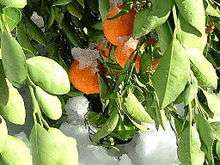
This Japanese tradition merged with European traditions related to the Christmas stocking. Saint Nicholas is said to have put gold coins into the stockings of three poor girls so that they would be able to afford to get married.[26] Sometimes the story is told with gold balls instead of bags of gold, and oranges became a symbolic stand-in for these gold balls, and are put in Christmas stockings in Canada[26][27] along with chocolate coins wrapped in gold foil.
Satsumas were also grown in the United States from the early 1900s, but Japan remained a major supplier.[28] U.S. imports of these Japanese oranges was suspended due to hostilities with Japan during World War II.[25] While they were one of the first Japanese goods allowed for export after the end of the war, residual hostility led to the rebranding of these oranges as "mandarin" oranges.[25]
The delivery of the first batch of mandarin oranges from Japan in the port of Vancouver, British Columbia (Canada), is greeted with a festival that combines Santa Claus and Japanese dancers[27]—young girls dressed in traditional kimonos.[29]
In Russia, mandarin oranges (tangerines) have traditionally been supplied from Morocco (though there exists a theory that it was only used to mask the supplies of Israeli tangerines during the period of particularly bad relations between Israel and Soviet Union) and are associated with that country, even though nowadays they are also supplied from other countries, e.g. Spain, Israel and Egypt. Another major supplier was a domestic region of Abkhazia in the Caucasus, and even after the Dissolution of the Soviet Union it continued to supply its characteristically yellow-greenish and particularly aromatic fruits to the central Russian regions. The eastern parts of the country, in turn, were generally supplied from China or Vietnam, and continue so nowadays, with the characteristic 10 and 20-pound plastic and cardboard boxes being the ubiquitous seasonal sight. Anyway, regardless of the supplier or variety, mandarin oranges were and are an iconic symbol of winter and the holiday season in Russia, in an interesting parallel with the same status it holds in Japan.
Historically, the Christmas fruit imported to North America was mostly Dancys, but now it is more often a hybrid.[30]
Genetics
Mandarins are one of the core ancestral citrus taxa, and are thought to have evolved in Vietnam, south China, and Japan.[31] Mandarins appear to have been domesticated twice, in the north and south Nanling Mountains.[32]The Tanaka classification system divided mandarins and similar fruit into numerous species, giving distinct names to cultivars such as willowleaf mandarins (C. deliciosa), satsumas (C. unshiu), tangerines (C. tangerina). Under the Swingle system, all these are considered to be varieties of a single species, Citrus reticulata.[33] Hodgson represented them as several subgroups: common (C. reticulata), Satsuma, King (C. nobilis), Mediterranean (willowleaf), small-fruited (C. indica, C. tachibana and C. reshni), and mandarin hybrids.[34]
Genetic analysis is consistent with mandarins representing a single species, with much of the variation within mandarins being due to hybridization.[35] There are only a small number of genetically-pure cultivars, including the Nanfengmiju, the Sun Chu Sha mandarin and the Tachibana, the latter of which is sufficiently divergent to be classified as a distinct subspecies.[35] The two original mandarin domesticates independently underwent hybridization with pomelo (C. maxima),[32] and a large group of cultivars arose from the initial mandarin-pomelo hybrids being backcrossed to produce mandarins with limited pomelo contribution.[35] Of these, an 'acidic' group including Sunki and Cleopatra mandarins, previously thought to be pure, contain a small region of introgressed pomelo DNA that results in them being too sour to be edible, but they are still widely used as rootstock and grown for juice.[33][35] Another group of mandarins, including some tangerines, Satsuma and King mandarins, show a greater pomelo contribution and derive from the limited-pomelo hybrids being crossed with sweet orange or pomelo, again followed by backcrossing in some cases.[35] The hybrid mandarins thus fall on a continuum with clementines, sweet and sour oranges, and grapefruit.[31] Mandarins and their hybrids are sold under a variety of names.
Varieties
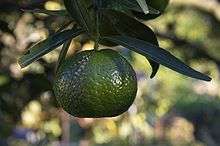
Pure mandarins
Non-pure mandarins
(Species names are those from the Tanaka system. Recent genomic analysis would place them all in Citrus reticulata.[35])
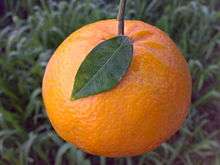
- Cleopatra mandarin,[31] acidic mandarin containing very small amount of pomelo introgression[35]
- Sunki,[31] acidic mandarin containing very small amount of pomelo introgression[35]
- Tangerines (Citrus tangerina)[38] is a grouping used for several distinct mandarin hybrids. Those sold in the US as tangerines have usually been Dancy, Sunburst or Murcott (Honey) cultivars. Some tangerine-grapefruit hybrids are legally sold as tangerines in the USA.[39][40]
- Mediterranean/Willowleaf/Thorny (Citrus × deliciosa), a mandarin with small amounts of pomelo[41]
- Huanglingmiao (Citrus reticulata), a mandarin–pomelo hybrid[35][42]
- Kishumikan (Citrus reticulata), or simply Kishu, close clonal relative of Huanglingmiao, the two sharing a common origin before diverging as they were propagated[35]
- Kunenbo (Citrus nobilis) a heterogeneous group that includes at least four distinct mandarin-pomelo hybrids.[43]
- King (in full, 'King of Siam', Citrus nobilis) a Kunenbo mandarin with high levels of pomelo admixture, sometimes classed as a tangor.[35][43]
- Kinnow (see image), a King-Willowleaf hybrid.
- Satsuma (Citrus unshiu), a mandarin-pomelo hybrid with more pomelo than seen in most mandarins, derived from a Huanglingmiao/Kishu backcross of a (non-King) Kunenbo that was a Huanglingmiao/Kishu-pomelo mix.[35][43] It is a seedless variety, of which there are over 200 cultivars, including Wenzhou migana, Owari, and mikan; the source of most canned mandarins, and popular as a fresh fruit due to its ease of consumption
- Owari, a well-known Satsuma cultivar that ripens during the late autumn
- King (in full, 'King of Siam', Citrus nobilis) a Kunenbo mandarin with high levels of pomelo admixture, sometimes classed as a tangor.[35][43]
- Kunenbo (Citrus nobilis) a heterogeneous group that includes at least four distinct mandarin-pomelo hybrids.[43]
- Komikan, a variety of Kishumikan[43]
- The Ponkan ( Citrus reticulata), a mandarin–pomelo hybrid[31][41]
- The Dancy tangerine (Citrus tangerina) is a hybrid, the cross of a Ponkan with another unidentified hybrid mandarin.[35] Until the 1970s, most tangerines grown and eaten in the USA were Dancys, and it was known as "Christmas tangerine"[30] and zipper-skin tangerine[44]
- Bang Mot tangerine, a mandarin variety popular in Thailand.
- Shekwasha (Citrus depressa), a very sour mandarin grown for its acidic juice, has admixture from both pomelo and citron[45]
Mandarin crosses
- Tangelos, a generic term for modern mandarin (tangerine)-pomelo and mandarin-grapefruit crosses
- The sour orange (Citrus x aurantium) derives from a direct cross between a pure mandarin and a pomelo[42]
- The common sweet orange (Citrus x sinensis), derives from a cross between non-pure mandarin and pomelo parents[42]
- Tangors, or Temple oranges, are crosses between the mandarin orange and the common sweet orange;[42] their thick rind is easy to peel and its bright orange pulp is sour-sweet and full-flavored. Some such hybrids are commonly called mandarins or tangerines.
- Clementine (Citrus × clementina), a spontaneous hybrid between a Willowleaf mandarin orange and a sweet orange.[41][46] sometimes known as a "Thanksgiving Orange" or "Christmas orange", as its peak season is winter; an important commercial mandarin orange form, having displaced mikans in many markets
- Clemenules or Nules, a variety of Clementine named for the Valencian town where it was first bred in 1953; it is the most popular variety of Clementine grown in Spain.[47]
- Fairchild is a hybrid of Clementine and Orlando, a tangelo
- Murcott, a mandarin–sweet orange hybrid,[41][48] one parent being the King.[49]
- Tango is a proprietary seedless mid-late season irradiated selection of Murcott developed by the University of California Citrus Breeding Program.[50]
- Clementine (Citrus × clementina), a spontaneous hybrid between a Willowleaf mandarin orange and a sweet orange.[41][46] sometimes known as a "Thanksgiving Orange" or "Christmas orange", as its peak season is winter; an important commercial mandarin orange form, having displaced mikans in many markets
- Grapefruit (Citrus x paradisi), the result of backcrossing the sweet orange with pomelo
- Meyer lemon (Citrus x meyer), a cross between a mandarin × pomelo hybrid and a citron.[45]
- Palestinian sweet lime (Citrus x limettioides), a distinct (mandarin × pomelo) × citron hybrid[45]
- Tangors, or Temple oranges, are crosses between the mandarin orange and the common sweet orange;[42] their thick rind is easy to peel and its bright orange pulp is sour-sweet and full-flavored. Some such hybrids are commonly called mandarins or tangerines.
- Rangpur lime (Citrus x limonia), a pure mandarin-citron cross[45]
- Rough lemon (Citrus x jambhiri), a pure mandarin-citron cross, distinct from rangpur[45]
- Jabara (Citrus jabara), a Kunenbo mandarin-yuzu cross.[43]
Non-mandarins
- Mangshanyegans, long thought to be mandarins, are in fact a separate species.[42]
See also
- Japanese citrus
- List of citrus fruits
- Tangerine
- Citrus unshiu
- Ju Song – "In Praise of the Orange-Tree"
References
- ↑ Pittman & Davis (1999-02-22). "Pittman & Davis – Premium Citrus Fruit Gifts – Why Are Tangerines So Tangy?". Pittmandavis.com. Retrieved 2012-11-17.
- ↑ "Market Watch: The wild and elusive Dancy". David Karp, LA Times. http://www.latimes.com/food/la-fo-marketwatch-20110128-story.html
- ↑ "International Citrus Genomics Consortium". University of California.
- 1 2 3 "Fruit Tree Seeds : Citrus reticulata". Retrieved 2018-03-18.
- ↑ Sergey Ivchenko (1965). Загадки цинхоны. Moscow: Molodaya Gvardiya. pp. 127–128.
- 1 2 3 "Citrus reticulata - General Information".
- 1 2 3 Геннадий Непокойчицкий (12 January 2017). Лечение растениями. Энциклопедический справочник. АНС, АСТ, Астрель, Харвест. pp. 588–. ISBN 978-5-457-27618-5.
- 1 2 Венедикт Андреевич Колесников (1959). Плодоводство. Государственное издательство сельскохозяйственной литературы.
- ↑ Sandy Baker (30 September 2011). The Complete Guide to Keeping Your Houseplants Alive and Thriving: Everything You Need to Know Explained Simply. Atlantic Publishing Company. pp. 144–. ISBN 978-1-60138-349-5.
- 1 2 Иван Александрович Бенедиктов (1953). Сельскохозяйственная энциклопедия. Гос. изд-во сельхоз. лит-ры.
- 1 2 3 4 Мороз В. Расскажите детям о фруктах. МОЗАИКА-СИНТЕЗ. pp. 14–. ISBN 978-5-86775-471-6.
- 1 2 Сергей Цигаль (12 January 2017). Полная чаша. ЛитРес. pp. 175–. ISBN 978-5-457-44211-5.
- ↑ Гл. редактор Горкин А.П. (2007). Биология: Современная иллюстрированная энциклопедия. Росмэн. pp. 263–. ISBN 978-5-353-02413-2.
- ↑ Справочник товароведа продовольственных товаров. Ėкономика. 1987.
- 1 2 3 Детское меню от 1 года до 7 лет с советами педиатра. ЛитРес. 12 January 2017. pp. 275–. ISBN 978-5-457-41939-1.
- ↑ "Chinese loanwords in the OED". The Free Library. Retrieved October 5, 2016.
- ↑ "mandarin | Origin and meaning of mandarin by Online Etymology Dictionary". www.etymonline.com. Retrieved 12 February 2018.
- ↑ Branch, Legislative Services. "Consolidated federal laws of canada, Food and Drug Regulations". laws.justice.gc.ca. Retrieved 2018-07-17.
- ↑ Yeung. Him-Che. Handbook of Chinese Herbs and Formulas. 1985. Los Angeles: Institute of Chinese Medicine.
- ↑ Chopra, R. N.; Nayar, S. L.; Chopra, I. C. Glossary of Indian Medicinal Plants. 1986. New Delhi: Council of Scientific and Industrial Research.
- 1 2 "Mandarin orange production in 2016, Crops/Regions/World list/Production Quantity (pick lists)". UN Food and Agriculture Organization, Corporate Statistical Database (FAOSTAT). 2017. Retrieved 18 March 2018.
- ↑ "Georgia exports 200 tonnes of mandarins to Ukraine". Agenda.ge. 30 November 2015. Retrieved 23 August 2017.
- ↑ "Deluge of Georgian Mandarins Set to Hit Russian Market". The Moscow Times. 27 November 2013. Retrieved 23 August 2017.
- ↑ "Faostat". Faostat.fao.org. Archived from the original on 2013-04-01. Retrieved 2013-12-19.
- 1 2 3 "Information on This Week's Product: Mandarin Oranges" (PDF). BC Agriculture in the Classroom Foundation. Retrieved 24 January 2013.
- 1 2 "Personalized Christmas Stockings". centrinet.com.
- 1 2 Marion, Paul (December 19, 2010). "Oranges at Christmas". richardhowe.com: Lowell Politics and Lowell History. Retrieved 15 January 2013.
- ↑ "HS195/CH116: The Satsuma Mandarin". Edis.ifas.ufl.edu. 2014-11-19. Retrieved 2018-04-09.
- ↑ "Christmas Stockings". Christmas Traditions in France and in Canada. Ministère de la culture et de la communication de France. Retrieved 15 January 2013.
- 1 2 Dancy Tangerine Citrus Tangerina v. Dancy, Ark of Taste Catalogue http://www.slowfoodusa.org/ark-item/dancy-tangerine
- 1 2 3 4 5 6 7 Curk, Franck; Ancillo, Gema; Garcia-Lor, Andres; Luro, François; Perrier, Xavier; Jacquemoud-Collet, Jean-Pierre; Navarro, Luis; Ollitrault, Patrick (2014). "Next generation haplotyping to decipher nuclear genomic interspecific admixture in Citrus species: analysis of chromosome 2". BMC Genetics. 15: 152.
- 1 2 Wang, Lun; et al. (2018). "Genome of Wild Mandarin and Domestication History of Mandarin". Molecular Plant. 11 (8): 1024–1037.
- 1 2 "New universal mitochondrial PCR markers reveal new information on maternal citrus phylogeny". Tree Genetics. 7: 49–61. doi:10.1007/s11295-010-0314-x.
- ↑ Goldenberg, Livnat; Yaniv, Yossi; Porat, Ron; Carmi, Nir (2018). "Mandarin fruit quality: a review". Journal of the Science of Food and Agriculture. 98: 18–26. doi:10.1002/jsfa.8495.
- 1 2 3 4 5 6 7 8 9 10 11 12 13 14 15 16 Wu, Guohong Albert; Terol, Javier; Ibanez, Victoria; López-García, Antonio; Pérez-Román, Estela; Borredá, Carles; Domingo, Concha; Tadeo, Francisco R; Carbonell-Caballero, Jose; Alonso, Roberto; Curk, Franck; Du, Dongliang; Ollitrault, Patrick; Roose, Mikeal L. Roose; Dopazo, Joaquin; Gmitter Jr, Frederick G.; Rokhsar, Daniel; Talon, Manuel (2018). "Genomics of the origin and evolution of Citrus". Nature. 554: 311–316. doi:10.1038/nature25447. and Supplement
- ↑ "Subacute toxicity assessment of carotenoids extracted from citrus peel (Nanfengmiju, Citrus reticulata Blanco) in rats". Regulatory Toxicology and Pharmacology. 62: 16–22. doi:10.1016/j.yrtph.2011.12.003.
- ↑ "The Seedless Kishu, a small but mighty mandarin". latimes.
- ↑ "Synonymy of C. tangerina at The Plant List".
- ↑ Larry K. Jackson and Stephen H. Futch. "Robinson Tangerine". ufl.edu.
- ↑ Commernet, 2011. "20-13.0061. Sunburst Tangerines; Classification and Standards, 20-13. Market Classification, Maturity Standards And Processing Or Packing Restrictions For Hybrids, D20. Departmental, 20. Department of Citrus, Florida Administrative Code". State of Florida. Retrieved 14 May 2015.
- 1 2 3 4 Velasco, R; Licciardello, C. "A genealogy of the citrus family". Nature Biotechnology. 32: 640–642. doi:10.1038/nbt.2954. PMID 25004231.
- 1 2 3 4 5 G Albert Wu; et al. "Sequencing of diverse mandarin, pomelo and orange genomes reveals complex history of admixture during citrus domestication". Nature. 32: 656–662. doi:10.1038/nbt.2906. PMC 4113729. PMID 24908277.
- 1 2 3 4 5 6 Shimizu, Tokurou; Kitajima, Akira; Nonaka, Keisuke; Yoshioka, Terutaka; Ohta, Satoshi; Goto, Shingo; Toyoda, Atsushi; Fujiyama, Asao; Mochizuki, Takako; Nagasaki, Hideki; Kaminuma, Eli; Nakamura, Yasukazu. "Hybrid Origins of Citrus Varieties Inferred from DNA Marker Analysis of Nuclear and Organelle Genomes". PLoS One. 11: e0166969. doi:10.1371/journal.pone.0166969.
- ↑ Larry K. Jackson and Stephen H. Futch. "HS169/CH074: Dancy Tangerine". ufl.edu.
- 1 2 3 4 5 6 7 8 9 Curk, Franck; Ollitrault, Frédérique; Garcia-Lor, Andres; Luro, François; Navarro, Luis; Ollitrault, Patrick (2016). "Phylogenetic origin of limes and lemons revealed by cytoplasmic and nuclear markers". Annals of Botany. 11: 565–583. doi:10.1093/aob/mcw005. PMC 4817432.
- ↑ Edible: An Illustrated Guide to the World's Food Plants. National Geographic. 2008. p. 73. ISBN 978-1-4262-0372-5.
- ↑ Toni Siebert (30 July 2009). "Nules". Citrus Variety Database. University Of California. Retrieved 9 June 2011.
- ↑ Stephen H. Futch and Larry K. Jackson. "HS174/CH078: Murcott (Honey Tangerine)". ufl.edu.
- ↑ Shimizu, Tokurou; Kitajima, Akira; Nonaka, Keisuke; Yoshioka, Terutaka; Ohta, Satoshi; Goto, Shingo; Toyoda, Atsushi; Fujiyama, Asao; Mochizuki, Takako; Nagasaki, Hideki; Kaminuma, Eli; Nakamura, Yasukazu (2016). "Hybrid Origins of Citrus Varieties Inferred from DNA Marker Analysis of Nuclear and Organelle Genomes". PLoS. 11 (11): e0166969. doi:10.1371/journal.pone.0166969.
- ↑ "Microsoft Word - Tango Information Sheet-4-12-2009.doc" (PDF). Retrieved 2018-04-09.
- Notes
- Citrus reticulata at Plants for a Future
External links
| Wikimedia Commons has media related to Citrus reticulata. |
